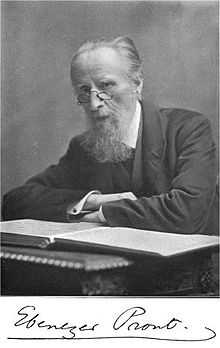Ebenezer Prout

Ebenezer Prout (1 March 1835 – 5 December 1909), was an English musical theorist, writer, teacher and composer, whose instruction, afterwards embodied in a series of standard works, underpinned the work of many British musicians of succeeding generations.
Career
Prout was born in Oundle. He studied pianoforte under Charles Salaman, but was otherwise self-taught. He attended the University of London intended for a career as a scholar, but chose to follow one in music through his love of it. From 1861 to 1873 he was organist of the Union Chapel, Islington. From 1861 to 1885 he was professor of the piano at the Crystal Palace School of Art.[1] He was awarded first prizes for a string quartet (1862) and a pianoforte quartet (1865) by the Society of British Musicians. In 1871–74 he became Editor of the Monthly Musical Record, and in 1874–79 was music critic for the Academy.
In 1879 he was appointed professor of harmony and composition at Royal Academy of Music in London, and became music critic of the Athenaeum. In 1884 he became professor at the Guildhall School of Music. In 1894 he was appointed Professor of Music in the University of Dublin, being awarded an Honorary Mus.Doc. in the following year. During this period he not only trained his students but delivered memorable public lecture series, notably one on the Bach cantatas illustrated by singers whom he had trained.
It was also to this period that his principal theoretical works belong, which became classics and were translated into many languages. Prout produced editions of many of the classics, not least for the Handel oratorios. He was directly connected with the rediscovery of the original wind parts for Messiah, from which new full and vocal scores were introduced by him to the Royal Society of Musicians in 1902. He was furthermore a composer of concert, church and chamber music.
As an editor, Prout reflected the practices of his own time in that he felt justified in replacing Handel's phrasing and expression marks with his own preferences. In this respect Prout differed from his contemporary Friedrich Chrysander, who was the first to produce an edition attempting to convey the composer's own intentions.
Among Prout's many students were Arthur Goring Thomas, Eugen d'Albert, John Waterhouse, Henry Wood and Edward German.
His son Louis Beethoven Prout (b. Hackney, 1864) was also a writer on musical theory, having trained under his father at the Royal Academy, and becoming professor at the Guildhall School. Louis Beethoven Prout's principal works are an Analysis of Bach's 48 Fugues (Weekes); Harmonic Analysis (Augener); Sidelights on Harmony (Augener); and Time, Rhythm and Expression (Augener). In addition Louis Beethoven Prout was a leading entomologist, being a foremost authority on the Geometridae, or geometer moths.[2]
Ebenezer Prout died in London.
Compositions
- Orchestral
- Concerto No. 1 in E minor for organ and orchestra, Op. 5
- Concerto No. 2 in E♭ major for organ and orchestra, Op. 35
- Minuet and Trio for orchestra, Op. 14
- Suite de ballet for orchestra, Op. 28 (1892)
- Symphony No. 1
- Symphony No. 2
- Symphony No. 3 in F major, Op. 22 (1885)
- Symphony No. 4
- Chamber and instrumental
- Concertante Duet in A major for piano and harmonium
- Piano Quartet No. 1 in C major, Op. 2 (1865)
- Piano Quartet No. 2 in F major, Op. 18
- Piano Quintet in G major, Op. 3
- Romance in F major for viola and piano, Op. 32
- Sonata for organ, Op. 4
- Sonata for flute and piano, Op. 17 (1883)
- Sonata in D major for clarinet (or viola) and piano, Op. 26 (1890)
- String Quartet No. 1, Op.1
- String Quartet No. 2 in B♭ major, Op. 15
- Organ arrangements
- Vocal
- Magnificat for solo voices, chorus and orchestra, Op. 7
- Evening Service (Magnificat and Nunc dimittis) in E♭ major for solo quartet, chorus, orchestra and organ, Op. 8
- Hereward (Hereward the Wake), Dramatic Cantata, Op. 12; words by William Grist
- The Morning and Evening Service Together with the Office for the Holy Communion, Set to Music in the Key of F, Op. 13
- Alfred (King Alfred), Dramatic Cantata, Op. 16; words by William Grist
- Freedom, Ode for baritone solo, chorus and orchestra, Op. 20; words by Peter Taylor Forsyth
- Queen Aimée, or The Maiden's Crown, Cantata for female voices (soli and chorus) and piano, Op. 21; words by Jetty Vogel
- The Hundredth Psalm for soprano solo, chorus and orchestra (organ ad lib.), Op. 23
- The Red Cross Knight, Dramatic Cantata in 6 scenes, Op. 24; words by William Grist
- Damon and Phintias, Dramatic Cantata for male voices (soli and chorus) and orchestra, Op. 25; words by R.W. Bloor
- Church music
Theoretical works
- Harmony, its Theory and Practice (1889, rev. 1901: 20 editions by 1903)
- Counterpoint (1890)
- Double Counterpoint and Canon (1891)
- Fugue (1891). New York, Greenwood Press Edition, 1969: ISBN 0-8371-1872-7[3]
- Fugal Analysis (1892)
- Musical Form (1893)
- Applied Forms (1895)
- The Orchestra, Vol I (1898)
- The Orchestra, Vol II (1899)
Notes
| Wikisource has original works written by or about: |
- ↑ Rosemary Williamson, Prout, Ebenezer Oxford Music Online
- ↑ Edward Alfred Cockayne (1944). "Obituary". The Entomologist's Record and Journal of Variation 56: 28. Retrieved 25 January 2012.
- ↑ Fugue. (WorldCat.org) at www.worldcat.org
Sources
- A. Eaglefield-Hull, A Dictionary of Modern Music and Musicians (Dent, London 1924).
External links
| Wikimedia Commons has media related to Ebenezer Prout. |
- Free scores by Ebenezer Prout in the Choral Public Domain Library (ChoralWiki)
|